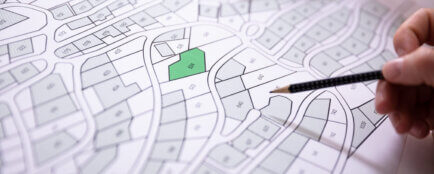How the mismatch occurs
A discrepancy between the entry in the Land Register and the actual state of the property means that the data in the Land Register do not correspond to the actual state of the property. This may be the case if there is a family house on the land, but it is not in the cadastre at all. It is then a so-called black building. Alternatively, you have an inherited house, but the owner is someone else in the land register.
The discrepancy in the cadastre may be of a technical or legal nature:
A technical discrepancy
A technical discrepancy consists of the wrong physical dimensions of the land or the location of the property in the terrain, which differ from the data recorded in the Land Registry. This includes errors in measurement, inaccuracies in the location of boundaries, etc.
Are you solving a similar problem?
Does the cadastral data not match?
Leave it to us. We will find out what your legal problem is and propose a solution, including a fixed price. You will receive a proposal and quote within 24 hours and if you use our services to solve your problem, we will refund your fee.
I want to help
- When you order, you know what you will get and how much it will cost.
- We handle everything online or in person at one of our 6 offices.
- We handle 8 out of 10 requests within 2 working days.
- We have specialists for every field of law.
Legal inconsistency
A legal inconsistency means that there is an error in the registration of rights to the property. Most often, these are errors in the ownership right, which arise when the ownership right listed in the cadastre does not correspond to the actual legal status of ownership.
Why is this a problem?
The actual status should always correspond to the cadastre. There may be a nosy neighbour who reports your black building. Or someone buys the neighbouring property and wants to sort out the property boundary, so you have to remove your brand new fence. However, the biggest problems can arise when you are going to do something with the property, such as sell it or mortgage it. Let’s look at these situations in more detail:
- Problems with planning permission: if you are planning to make changes to your property, such as adding another room, changing its purpose (e.g. changing a flat into a business premises), renovating it or perhaps demolishing it, you may have problems getting planning permission.
- Problems with mortgaging your property: if you want to mortgage your property (for example, to buy another property), you probably won’t get away with it. The bank will only take mortgages on properties where everything is in order at the Land Registry.
- Problems when selling a property: when selling a property, it is crucial that all details of the property are up to date and correctly recorded in the Land Registry. If there is a discrepancy in the records of ownership, the condition of the property or legal restrictions, it will make the sale very difficult. No one wants to buy a property with something wrong with it.
Tip for article
Tip: Are you planning to sell or buy a property? We will provide you with a complete contractual and legal service related to the purchase or sale of real estate. We can do it within 48 hours, flawlessly and professionally.
Digitisation of the Land Registry
In recent years, the cadastral map has been converted into digital form. As a result, the cadastre has revealed a number of inconsistencies, especially for older properties. Along with this, many ordinary citizens have started to address the inconsistencies and sometimes in a rather indiscriminate way.
Disputes over property boundaries after digitisation became frequent. A lot of land was demarcated by eye and not much consideration was given to whether there were a few metres missing on one side and excess on the other. A lot of neighbours agreed to leave the boundaries as they are or to exchange land with each other. However, some people decided to solve the situation radically – the given part of the land is theirs and they do not care that a part of the neighbour’s house, fence or garage encroaches on it.
However, these people have often failed. This is because the so-called ” possession” came into play. It is possible to hold on to a property if the owner has continuously held the property for at least ten years (e.g. the house has stood on the land for more than 10 years) and at the same time was convinced that the property belonged to him and had the title (e.g. the purchase contract).
It is also possible to hold the property without a title but only if the owner has held the property for at least 20 years. The period during which the property was held by the former owner counts towards the total holding period.
Tip for article
Tip: This year a new building law came into force. Read what changes it brings.
How do you know it doesn’t apply to you?
If you are concerned that your property may be affected by a non-compliance but are unsure, it is easy to check. Just look at the Land Registry. There you will find all the information relating to your property – titles of acquisition (e.g. purchase contracts), geometric plans, mortgage agreements, easements, etc.
You can access it online via the website of the State Administration of Surveying and Cadastre. Here you can find your property by entering the parcel number, housing unit number or manually on the cadastral map. In addition, you can also open the cadastral map on mapy.cz, where you can easily check whether the cadastral boundaries of your land or the layout of your house correspond to reality using satellite images.
Tip for article
Tip: You can learn more about consulting the cadastre and changing the data in it in our next article.
How to resolve the discrepancy in the cadastre?
The solution depends on whether it is a technical or legal discrepancy:
Technical non-compliance
In this case, you need to file a petition to correct the erroneous cadastral data. However, it can only be filed for discrepancies that occurred after 1964 (specifically 1 April). For older errors, the same solution must be chosen as for a legal inconsistency.
The cadastral office itself may also proceed to correct a technical discrepancy if it discovers the error itself. Once the error has been corrected, you will receive a notification of the correction.
If you disagree with the correction, you can send your disagreement to the Land Registry within 30 days. The cadastral office will then start the procedure to correct the error. This involves the cadastral office examining the reasons that led to the correction of the discrepancy and also considering the reasons for your disagreement. In addition, it may also propose an oral hearing with you and other persons concerned.
Legal non-compliance
In the case of a legal non-compliance, the solution is a little more complicated, specifically there are two options:
- A note of conflict or controversy: a note of conflict can be filed if the right in rem was registered in the land register in accordance with the actual situation, but this has changed, thus creating a discrepancy. A disputability remark is possible in the case where the right in rem has never been registered in the cadastre. Together with these remarks, an action to establish the right of ownership or an action to establish the boundary must also be brought.
- Application for registration: if the discrepancy was caused by an erroneous document that was used to create the registration (i.e. the information in the cadastre corresponds to the document, but the document itself is erroneous), then you can resolve the discrepancy simply by filing an application for registration in the cadastre, which will remove the discrepancy.
Summary
The discrepancy between the information in the cadastre and the actual situation may be of a technical or legal nature. A technical discrepancy involves errors in measurements, etc., while a legal discrepancy refers to errors in property law. The issue of non-compliance can complicate changes relating to the property such as sale, reconstruction, and requires legal action to resolve it, such as correcting the erroneous entry, noting a dispute or controversy with a lawsuit, or a new application for registration.




